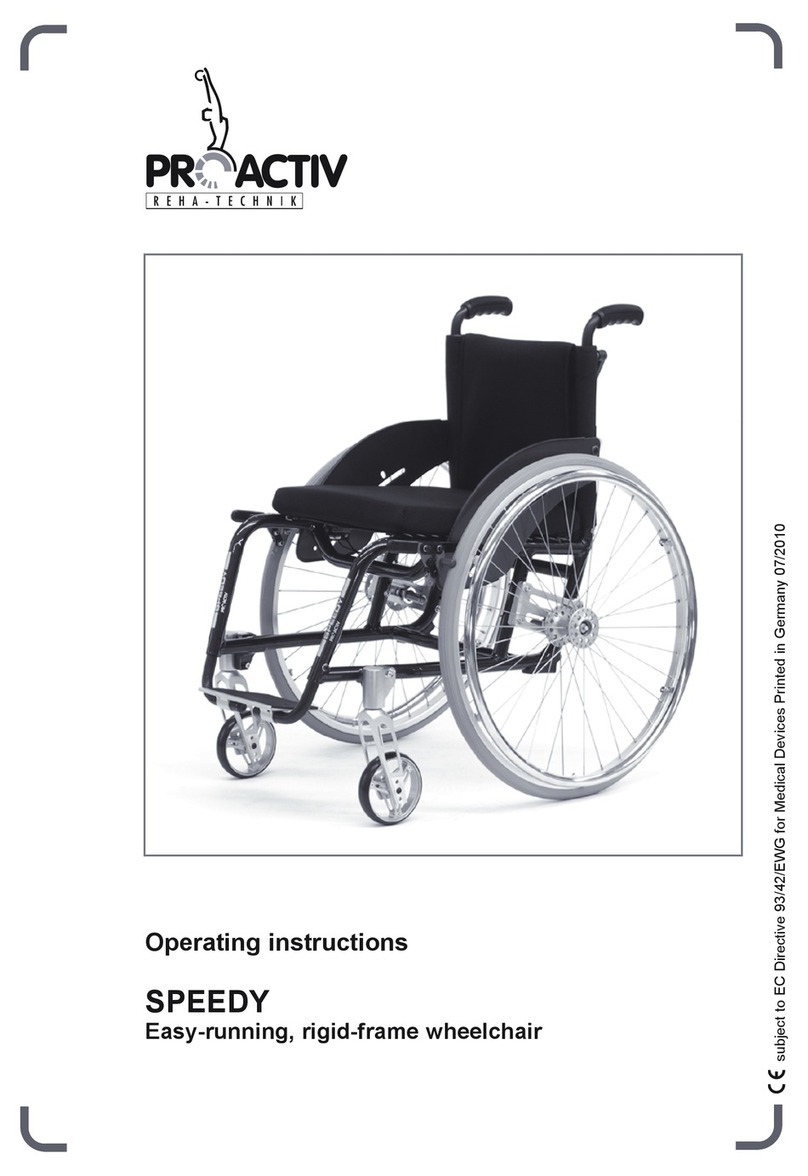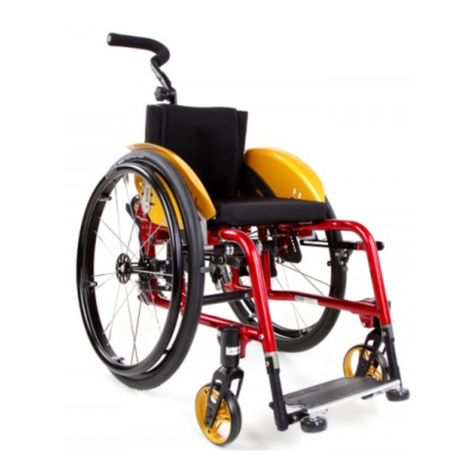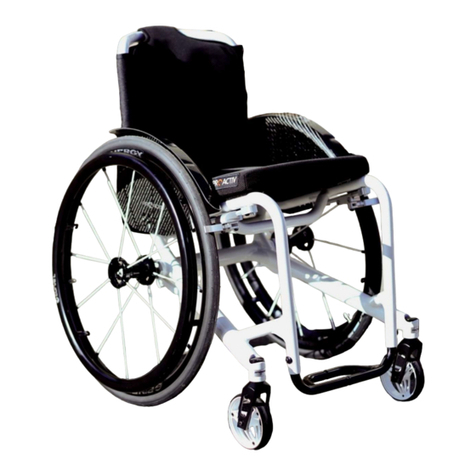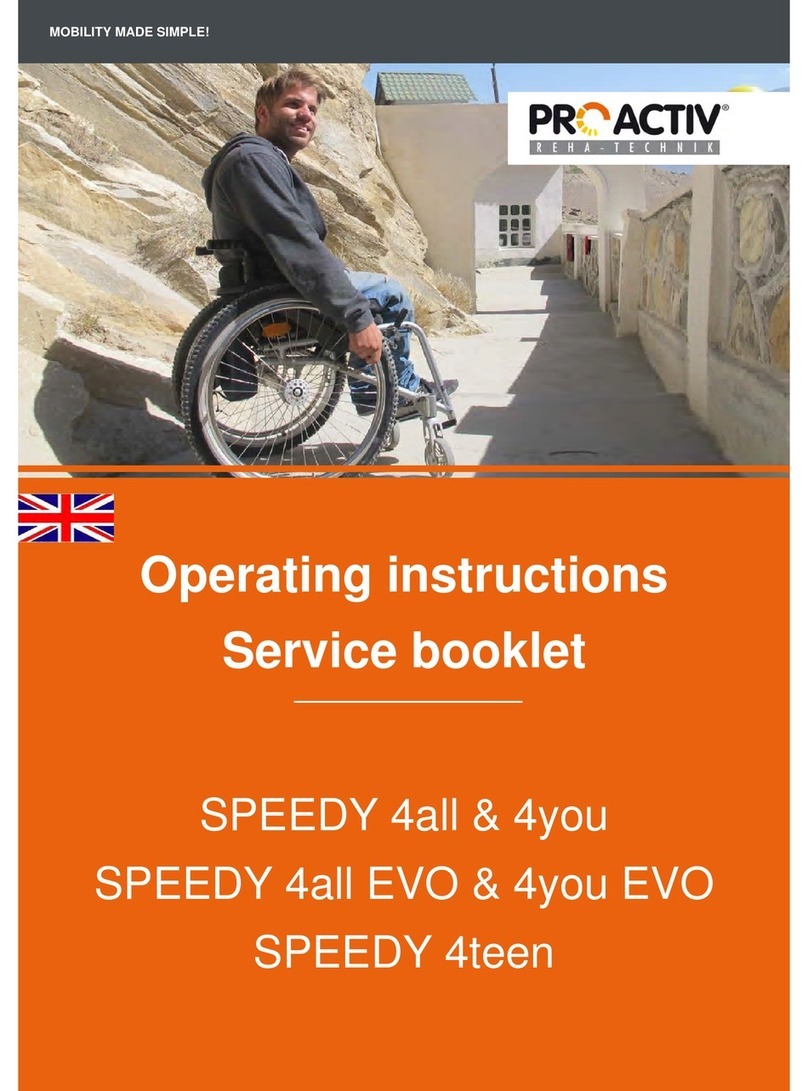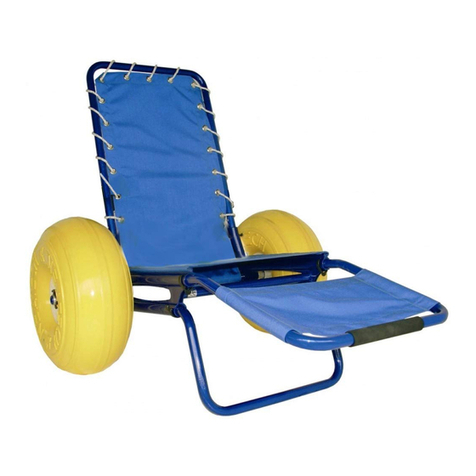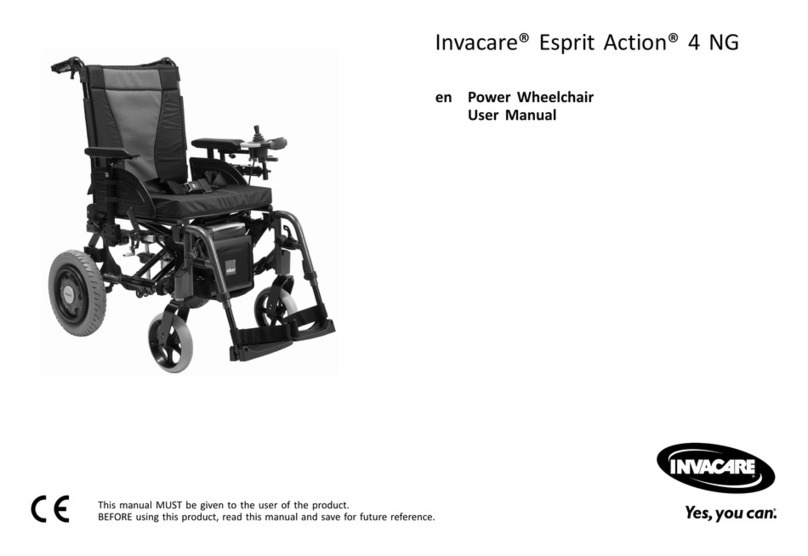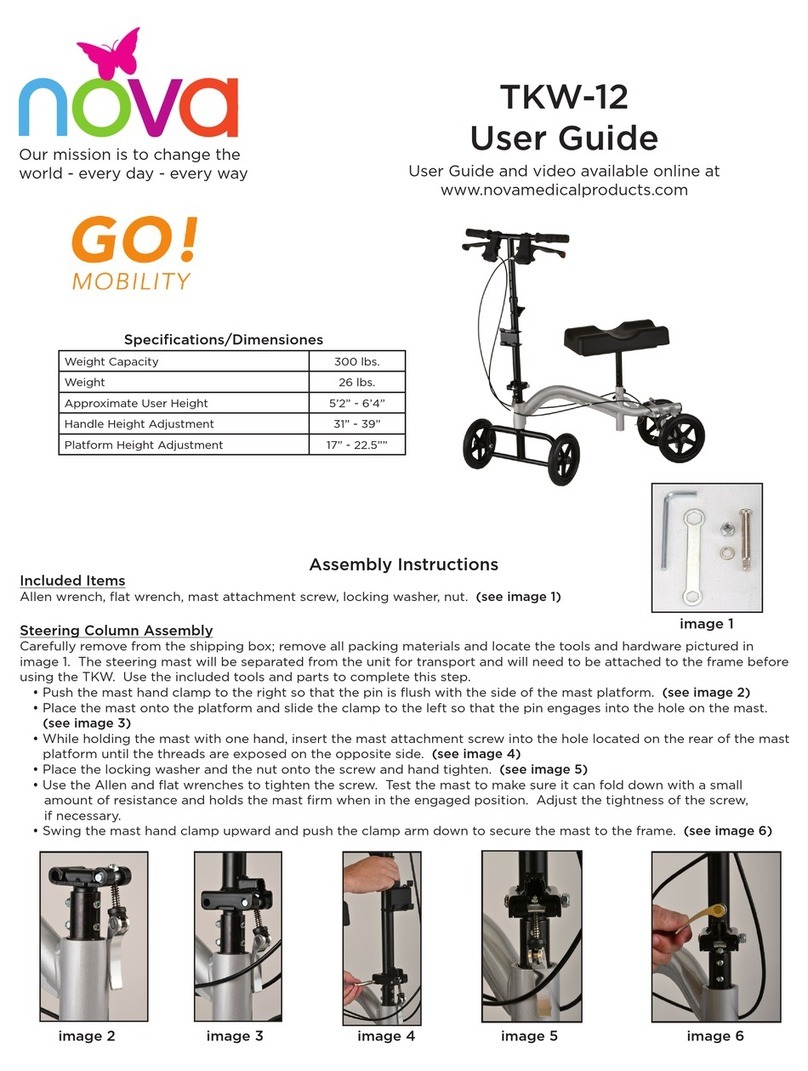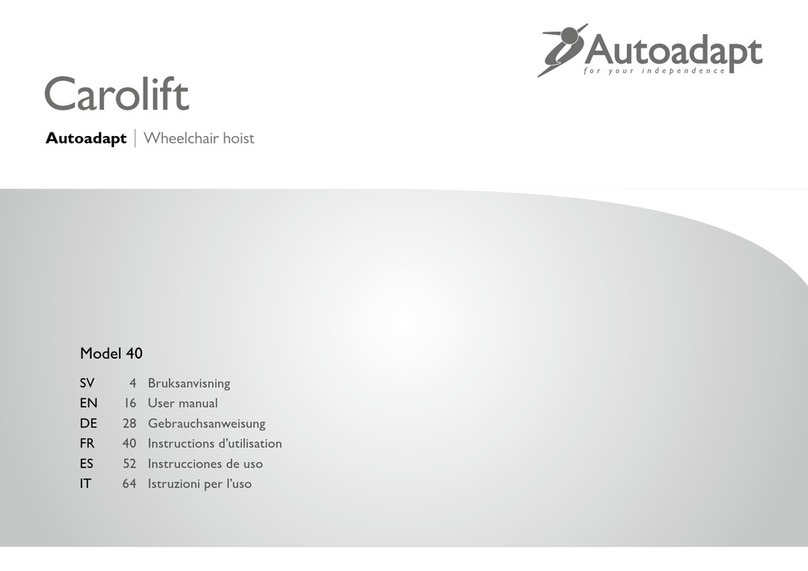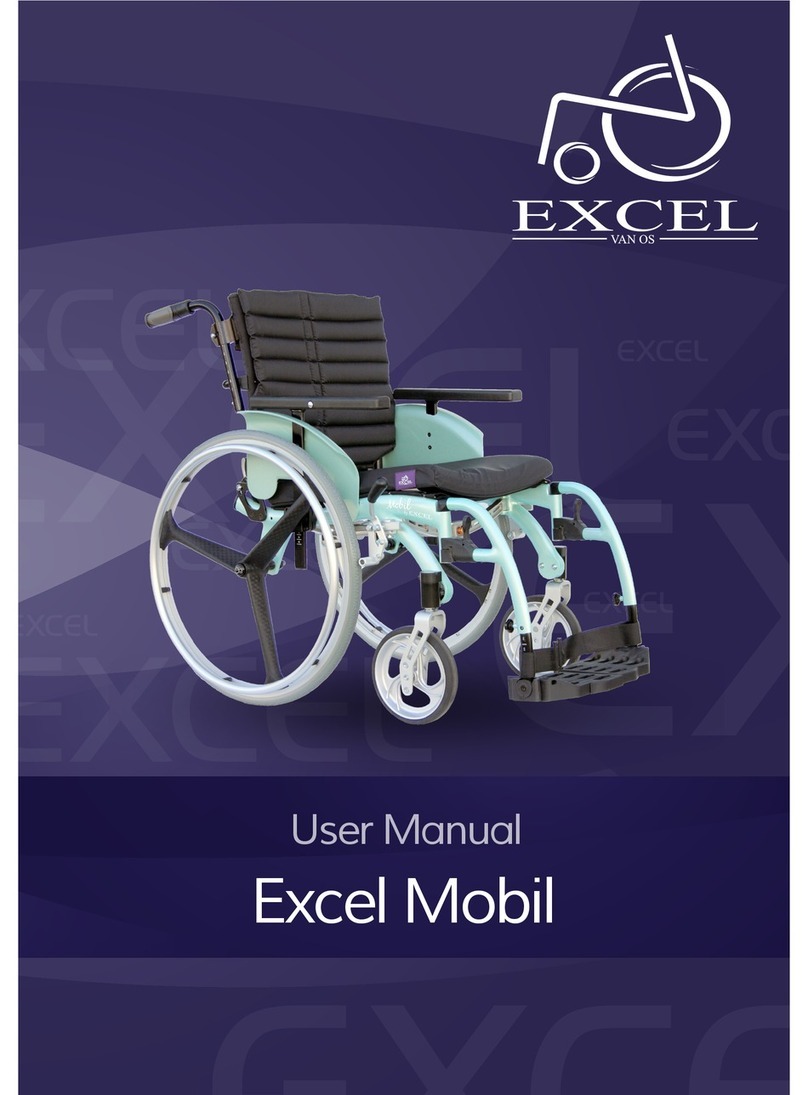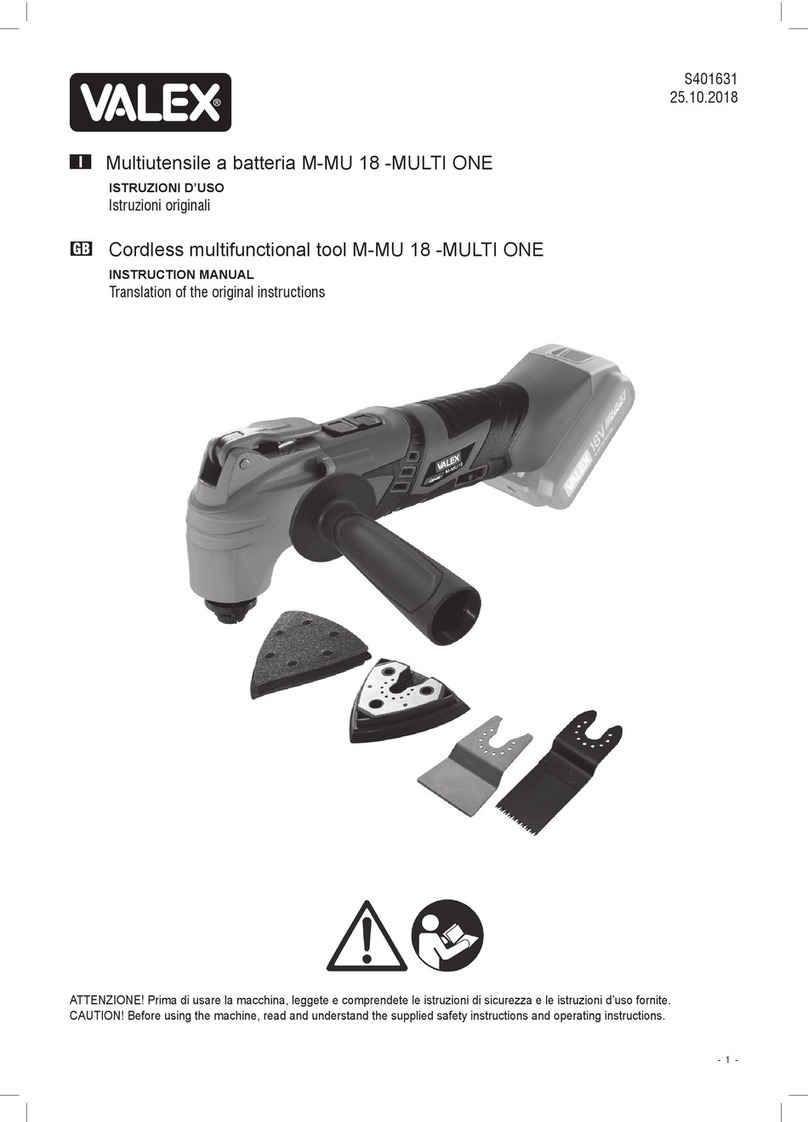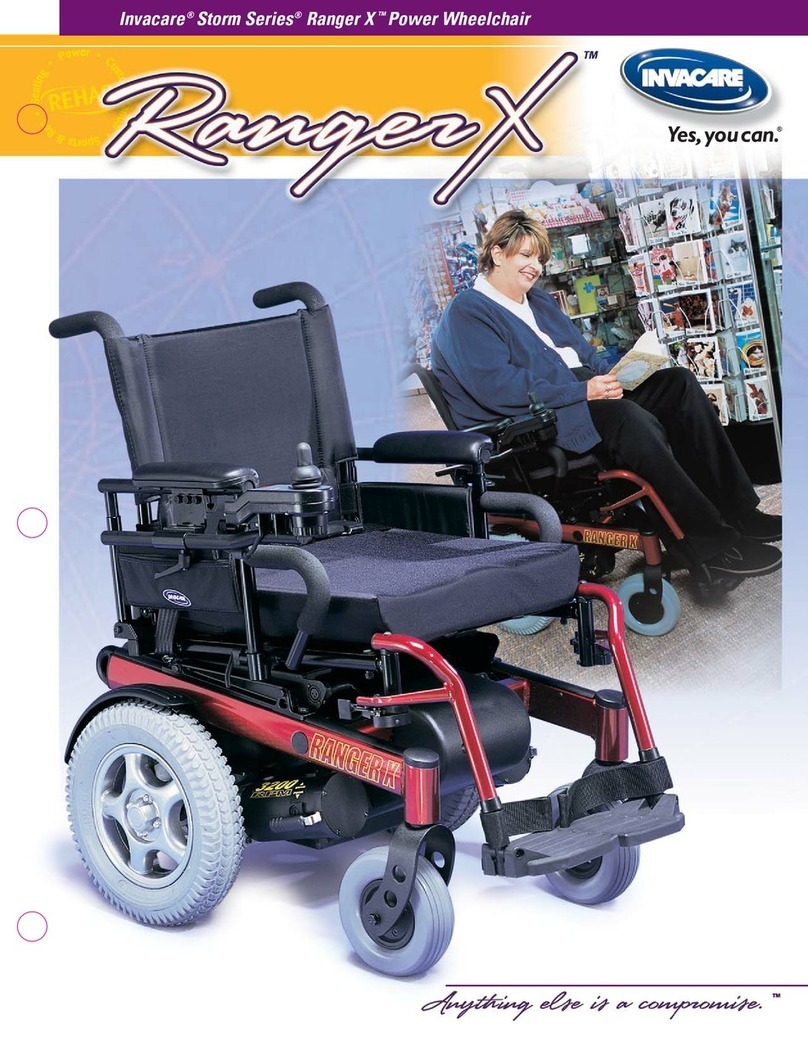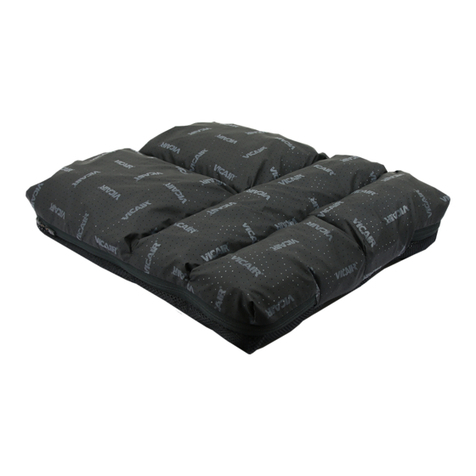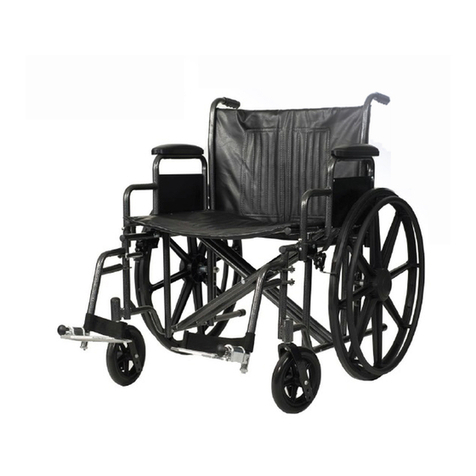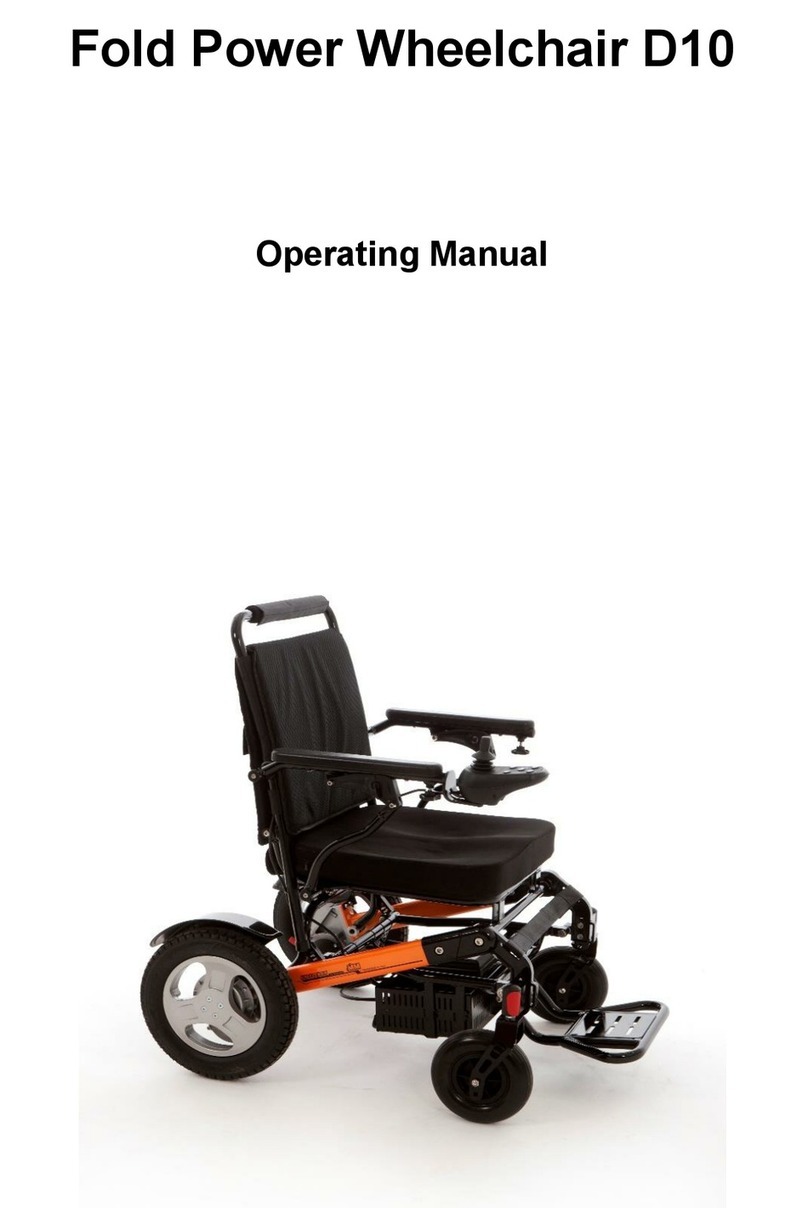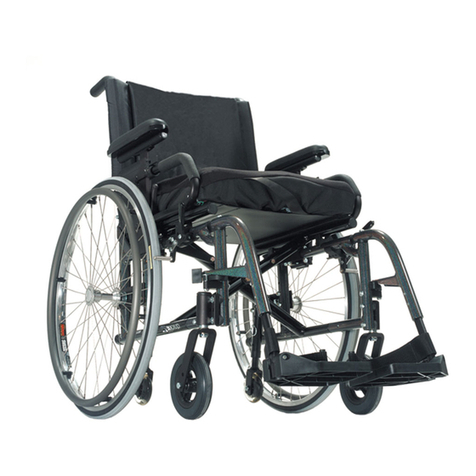ProActiv TRAVELER 4all Ergo Parts list manual

TRAVELER 4all Ergo & 4you Ergo usage instructions
0
Usage instructions
Service booklet
TRAVELER
4all Ergo & 4you Ergo

TRAVELER 4all Ergo & 4you Ergo usage instructions
1
Contents
1 Preface ............................................................................................................................................... 5
2 Legend ................................................................................................................................................ 5
3 Conformity/other information .............................................................................................................. 5
3.1 Classification ............................................................................................................................... 5
3.2 Conformity................................................................................................................................... 5
3.3 Manufacturer ............................................................................................................................... 5
4 Scope of delivery and testing the product on receipt ......................................................................... 5
5 Introduction ......................................................................................................................................... 6
6 Purpose and indication ....................................................................................................................... 6
7 Proper use .......................................................................................................................................... 7
8 Technical specifications ..................................................................................................................... 7
8.1 Product weight ............................................................................................................................ 7
8.2 Load weight................................................................................................................................. 7
8.3 Obstacle height and turning circle .............................................................................................. 7
8.4 Basic equipment and dimensions ............................................................................................... 7
8.5 Service life .................................................................................................................................. 8
9 Rating plate & markings on the product ............................................................................................. 8
10 Commissioning and handover ............................................................................................................ 8
11 Introduction to the product and the surroundings ............................................................................... 8
12 Safety instructions – prior to driving/use ............................................................................................ 9
13 Safety instructions – while driving/using .......................................................................................... 10
14 Safety instructions regarding obstacles ........................................................................................... 11
15 Safety instructions regarding dangerous locations and dangerous situations ................................. 11
16 Safety instructions – after driving/use .............................................................................................. 12
17 Folding mechanism .......................................................................................................................... 12
17.1 Folding and pack size ............................................................................................................... 12
17.2 Folding in or passing through narrow spaces ........................................................................... 13
17.3 Safety instructions .................................................................................................................... 14
18 Individual setting options ............................................................................................................ 14
18.1 Adapting the seat height at the back ........................................................................................ 14
18.1.1 General instructions ..................................................................................................... 15
18.2 Adjusting the seat height at the front / angle of seat ................................................................ 16
18.2.1 Adapting by positioning the caster wheels in the caster fork ....................................... 16
18.2.2 Adaptation by replacing the caster fork ....................................................................... 16
18.2.3 General instructions ..................................................................................................... 16
18.3 Adjusting the tipping point ......................................................................................................... 17

TRAVELER 4all Ergo & 4you Ergo usage instructions
2
18.3.1 Terms, inlets and folding mechanism middle section .................................................. 17
18.3.2 Adaptation via horizontal positioning of the wheel plate .............................................. 18
18.3.3 General instructions ..................................................................................................... 19
19 Back system ..................................................................................................................................... 20
19.1 Backrest angle .......................................................................................................................... 20
19.1.1 Adjustment possibilities with an adjustable backrest ................................................... 20
19.1.2 Instructions for sitting posture with an adjustable backrest ......................................... 20
19.1.3 Adjusting the backrest angle or folding down the backrest with an adjustable
backrest....................................................................................................................... 20
19.2 Adjustable back & its adjustment options ................................................................................. 21
19.3 Ergonomic back shell & its setting options ............................................................................... 24
20 Seat system ...................................................................................................................................... 25
21 Clothing guard .................................................................................................................................. 26
21.1 Overview of terms ..................................................................................................................... 26
21.2 Removal and attachment of the clothing guard ........................................................................ 26
21.3 Adjusting the clothing guard position.................................................................................. 27
21.4 Adjusting the force required for removing and installing .................................................... 28
21.5 Clothing guard size ............................................................................................................. 29
22 Drive wheels ..................................................................................................................................... 30
22.1 Removing and attaching the drive wheels ................................................................................ 30
22.2 Checking and adjusting the wheel tracking of the drive wheel .......................................... 31
22.3 Wheel camber .................................................................................................................... 32
22.4 Tyre pressure ............................................................................................................................ 32
22.5 Wheelbase extension ............................................................................................................... 33
22.6 Other ......................................................................................................................................... 34
23 Caster wheels ................................................................................................................................... 35
23.1 Replacing the caster wheels .............................................................................................. 35
23.1.1 Replacing the caster wheels when mounted using two axle fixing screws ................. 35
23.1.2 Replacing the caster wheels when mounted using an axle fixing screw and nut ........ 35
23.2 Caster wheels flapping ............................................................................................................. 36
23.3 Replacing the caster forks ........................................................................................................ 37
23.3.1 Caster fork with screwed axle................................................................................ 37
23.3.2 Caster forks with quick-release axles .......................................................................... 38
23.4 Adjustment of the caster fork rotary axles .......................................................................... 38
24 Footrests ........................................................................................................................................... 40
24.1 Angle adjustment of the footplate support .......................................................................... 40
24.2 Removing and attaching the footrest ........................................................................................ 40

TRAVELER 4all Ergo & 4you Ergo usage instructions
3
24.3 Footrest continuous .................................................................................................................. 41
24.4 Footrest folding up to one side ................................................................................................. 42
24.5 Footrest folds up to the rear with spring locking mechanism ................................................... 44
24.6 Divided footrest ......................................................................................................................... 45
24.7 Swing away footrest .................................................................................................................. 46
24.8 Safety instructions .................................................................................................................... 47
25 Anti-tipping support........................................................................................................................... 47
25.1 Operating and passive position ................................................................................................ 47
25.2 Removing and attaching the anti-tipping support ............................................................... 48
25.3 Height adjustment of the anti-tipping support ..................................................................... 50
25.4 Safety instructions .................................................................................................................... 51
26 Brakes .............................................................................................................................................. 51
26.1 Knee lever brake ....................................................................................................................... 51
26.1.1 Opening and closing the brake .................................................................................... 51
26.1.2 Setting the brake ................................................................................................... 52
26.2 Integral parking brake ............................................................................................................... 53
26.2.1 Opening and closing the brake .................................................................................... 53
26.2.2 Brake adjustment with standard installation .......................................................... 54
26.2.3 Brake adjustment for installation with clamping bracket ....................................... 55
27 Push handles .................................................................................................................................... 56
27.1 Back tube with integrated handles ............................................................................................ 56
27.2 Aluminium push handles fixed in back tube ............................................................................. 57
27.3 Push handles, horizontally screwed in back tube ..................................................................... 57
27.4 Safety push handles with continuous height adjustment .......................................................... 57
27.5 Safety push handles back-positioned ....................................................................................... 58
27.6 Safety instructions .................................................................................................................... 59
28 Passenger transport in motor vehicles ............................................................................................. 59
28.1 Standard specifications ............................................................................................................. 59
28.2 Restraint systems ..................................................................................................................... 59
28.3 Marking ..................................................................................................................................... 60
28.4 Fastening the wheelchair in the vehicle .................................................................................... 60
28.5 Handling instructions and positioning the wheelchair in the vehicle ........................................ 61
28.6 Safety instructions .................................................................................................................... 64
29 Storage ............................................................................................................................................. 64
30 Transport .......................................................................................................................................... 64
30.1 Securing handling of the product .............................................................................................. 64
30.2 Passenger transport in vehicles ............................................................................................... 64

TRAVELER 4all Ergo & 4you Ergo usage instructions
4
30.3 Securing the product in a vehicle (without a person) ............................................................... 65
30.4 Passenger transport over obstacles in the product .................................................................. 65
31 Malfunctions ..................................................................................................................................... 66
32 Cleaning and care ............................................................................................................................ 66
33 Maintenance ..................................................................................................................................... 66
33.1 General instructions .................................................................................................................. 66
33.2 Service schedules ..................................................................................................................... 67
33.3 Proof of maintenance ................................................................................................................ 67
34 Disposal & recycling ......................................................................................................................... 68
35 Re-use .............................................................................................................................................. 68
36 Warranty ........................................................................................................................................... 69
37 Liability .............................................................................................................................................. 69
38 Appendix: Tightening torques, securing details and tools ................................................................ 70
39 Appendix: Medical product passport/record of training .................................................................... 71
40 Appendix: Hand-over certificate ....................................................................................................... 72
40.1 Required compliance criteria to authorise use ......................................................................... 72
40.2 Check list for training the user .................................................................................................. 73
41 Appendix: Inspection lists ................................................................................................................. 74
The following instructions are intended for and may only be carried out by the rehabilita-
tion specialist dealer or PRO ACTIV.
This document is available in PDF format at
www.proactiv-gmbh.com for visually impaired people. Using the zoom function, the font
can be increased as desired.

TRAVELER 4all Ergo & 4you Ergo usage instructions
5
1 Preface
Dear Customer,
Congratulations on purchasing your new
PRO ACTIV product. You have bought a quali-
ty product that has been specially customised
to meet your requirements. We have put to-
gether some instructions about its proper and
safe use in the following document. Please
read these instructions before using the
product.
The standard components are explained in
these usage instructions. If you have individual
solutions or non-standard components on your
product, your rehabilitation specialist dealer or
PRO ACTIV would be happy to deal with any
questions you may have about using it.
The TRAVELER 4all Ergo & 4you Ergo differ
in the options for individual design of the frame
geometry. The operating instructions are
identical.
You can always download the latest version of
the usage instructions as a PDF document in
our download area at www.proactiv-gmbh.com
If you have any further questions about this or
any of our other products, we would be glad to
be at your disposal.
Enjoy your trips and the best possible mobility.
Your PRO ACTIV team
2 Legend
The symbols used in these usage instructions
have the following meanings:
Manufacturer
Note
Serial number
3 Conformity/other information
3.1 Classification
TRAVELER 4all Ergo & 4you Ergo folding
frame wheelchairs (referred to as a "product"
below) are classified as a class I product.
3.2 Conformity
As the manufacturer, PRO ACTIV
Reha-Technik GmbH declares that
the respective product is a class I product and
meets the requirements of the EU Medical
Devices Directive (2017/745).
If the product is adapted in a manner which
has not been agreed by PRO ACTIV Reha-
Technik GmbH, this declaration becomes void.
3.3 Manufacturer
PRO ACTIV Reha-Technik GmbH
Im Hofstätt 11
D-72359 Dotternhausen
Phone +49 7427 9480-0
Fax +49 7427 9480-7025
e-mail: info@proactiv-gmbh.de
web: www.proactiv-gmbh.com
4 Scope of delivery and testing
the product on receipt
Delivery includes the product, configured as
per the purchase order, with the usage instruc-
tions including the training/hand-over certificate
and inspection lists. You can view the basic
equipment in the chapter entitled "Technical
specifications". As per your order, the product
is equipped with additional recommended ac-
cessories, such as push handles, anti-tipping
supports and a lap belt.
Please check that the delivery is complete after
you have received your product.
The product is tested to ensure it is completely
functional before shipping and packed in spe-
cial boxes.

TRAVELER 4all Ergo & 4you Ergo usage instructions
6
However, please check the product immediate-
ly upon receipt, preferably in the presence of
the freight company, for any damage which
may have occurred in transit. If you are of the
opinion that damage has occurred during
transit, please do the following:
1. Record a statement of facts in the pres-
ence of the freight company - photo docu-
mentation of the packaged product and the
unpacked product with detailed images of
product damage.
2. Preparation of a declaration of assignment
- you assign all claims from this damage to
the freight company.
3. Statement of facts/photo documentation,
delivery note, and declaration of assign-
ment are sent to PRO ACTIV.
Failing to observe these instructions, or report-
ing damage after acceptance, means that the
damage cannot be acknowledged.
PRO ACTIV will subsequently review the dam-
age and discuss the further procedure with you
(shipment of replacement parts, returning the
product to PRO ACTIV for a complete repair,
etc.).
5 Introduction
Before starting your first journey, familiarise
yourself with these usage instructions, paying
particular attention to all of the safety infor-
mation and hazard warnings contained in
them.
Allow your therapists and doctors to advise
you, your carers, and assistants on how to use
the product and what you are safe to do with
the product based on your current ability. Clari-
fy with them as well which wheelchair tech-
niques you can learn on the basis of your
ability.
Under no circumstances should you do
anything with or in the product that you have
not learned to do and have not mastered.
You, your carers and assistants should also
seek advice from your therapists and doctors
as well as the rehabilitation specialist dealer
about the use and settings of your product as
well as the safety accessories available (e.g.
anti-tipping supports and lap belt).
You should always heed the advice pro-
vided by doctors, therapists and the rehabilita-
tion specialist dealer on the necessary safety
accessories.
If you are not sure how to handle the
product or if technical faults occur, please con-
tact your rehabilitation specialist dealer or
PRO ACTIV before using it.
Never leave the product unattended.
Secure the product against unauthorised
use and theft.
When combining your product with
equipment made by other manufacturers (e.g.
seat cushion, drive devices, etc.), make sure
that the serviceability of the individual compo-
nents and the unit made up of them is ensured.
You can get information on the suitability of a
combination from the manufacturer of the third-
party components or from your rehabilitation
specialist retailer.
The product contains small parts that may
pose a choking hazard for children.
6 Purpose and indication
This product offers persons who have difficulty
walking or cannot walk the option of replacing
walking with driving using a muscle-powered
wheelchair to a technically feasible extent. The
objective is to maintain or increase the greatest
possible independent mobility and to integrate
the active wheelchair user in everyday life.
Indications: Walking impediment or limited
ability to walk due to paralysis, limb loss, limb
defect/deformation, joint contractions/joint
damage, neurological and muscular diseases.
Contraindications: Some wheelchair options
are unsuitable for certain disease profiles or
handicaps. A suitable selection will be made by
the therapist/doctor/rehabilitation specialist
dealer during the consultation.

TRAVELER 4all Ergo & 4you Ergo usage instructions
7
In addition - for safety reasons - the product
may only be operated by people who
• can move and coordinate their hands and
arms so that they are able to operate all
control elements without restrictions while
using the wheelchair.
• are physically and mentally capable and
have the visual ability to safely operate the
product in all operating situations and can
meet the legal requiremenlts for use on
public roads. For children or people with
mental, significant motor or visual impair-
ments, the attendants can ensure the re-
quired traffic safety as a substitute and as
a companion.
• have been trained in its use by the rehabili-
tation specialist dealer or PRO ACTIV.
7 Proper use
This wheelchair is designed for use on level
and solid surfaces indoors and outdoors. Avoid
driving on unpaved or loose surfaces (e.g. on
loose gravel, in sand, mud, snow, ice or
through deep puddles of water, and under poor
weather conditions (e.g. storms), as this may
result in incalculable risks. This wheelchair’s
outstanding feature is the folding mechanism,
which folds partially for reduced width to fit
through narrow spaces, in addition to folding
up fully.
The maximum permitted load of the product in
its standard design is 120 kg. The heavy-duty
version and individual customisations can be
designed for a higher load; this is then indicat-
ed on the rating plate. Please note that the
load limit indicated on the rating plate may not
be exceeded even when transporting objects
and carrying out strength exercises in the
product. Note that the maximum load weight is
reduced accordingly when mounting compo-
nents with low load limits on the product, e.g.
drive wheels with few spokes.
Proper use of the product is a basic require-
ment of safe operation. The product may gen-
erally be used only for applications that are
listed and described in these usage instruc-
tions. This includes storage, transport,
maintenance/inspection, and repair, as well as
the safety information in each chapter of these
usage instructions.
8 Technical specifications
8.1 Product weight
The total weight starts from 11.2 kg with the
basic equipment.
8.2 Load weight
Maximum load weight:
Up to 120 kg payload
The heavy-duty version and individual custom-
isations can be designed for a higher load; this
is then indicated on the rating plate.
8.3 Obstacle height and turning circle
Maximum traversable/negotiable obstacle
height: 10 cm
Turning circle:
approx. 1.3 m without manoeuvring back
and forth
approx. 1.1 m with manoeuvring back and
forth (strongly dependent on the number of
manoeuvres)
8.4 Basic equipment and dimensions
In the basic equipment, the product is
equipped with seat and back system, side
sections, caster wheels, drive wheels including
tyres and handrims, knee lever brake and
footrest.
Dimensions, TRAVELER 4all Ergo:
Seat width: 33 - 52 cm
Seat depth: 36 - 48 cm
Back height: 20 - 48 cm
Wheel camber: 1°, 4°, 6°
Back angle: Seat tube / back tube opening
angle 70°-95°

TRAVELER 4all Ergo & 4you Ergo usage instructions
8
Dimensions, TRAVELER 4you Ergo:
Seat width: 33 - 52 cm
Seat depth: 35 - 48 cm
Back height: 22-48 cm
Wheel camber: 1°, 4°, 6°
Back angle: Seat tube / back tube opening
angle 70°-95°
8.5 Service life
The service life of the product is 6 years.
9 Rating plate & markings on the
product
The rating plate is located on the product
frame. The rating plate includes the precise
model, the serial number and other technical
specifications.
When contacting your rehabilitation specialist
dealer or PRO ACTIV with regard to your
product, please always have the serial number
and year of construction on the rating plate at
hand.
CE marking
“European conformity”
Medical device
Manufacturer
Follow the usage instructions
Serial number
Date of manufacture
The product is labelled with further symbols
(stickers):
Product not approved as a seat in mo-
tor vehicles
Product approved as a seat in motor
vehicles; marking of the transport re-
straint system connections on the
wheelchair or fastening points for
wheelchair restraint systems
More detailed information about this can be found
in Chapter 28.
10 Commissioning and handover
The product will be handed over to you ready
for use by a rehabilitation specialist dealer or a
field representative or by a product consultant
from PRO ACTIV.
You will be fully instructed in the use of the
product based on the usage instructions in-
cluded in the delivery. You will be handed over
a record of training and handover certificate as
written proof. In addition, you will be handed
the usage instructions and, if necessary, fur-
ther accessories for your own use. It is rec-
ommended that you take along an assistant to
the training so that, if required, they can assist
you later when handling the product.
During the hand-over, the record of training
(Chapter 39) and the hand-over certificate
including the associated check list (Chapter
40) must be filled in. The rehabilitation special-
ist dealer should send the completed docu-
ments to PRO ACTIV for filing as a file by e-
mail or in the form of a copy by fax or in the
post.
11 Introduction to the product and
the surroundings
During the initial commissioning of the product,
drive at minimum speed and become accus-
tomed to the driving characteristics of the
product. Always adapt the speed and driving

TRAVELER 4all Ergo & 4you Ergo usage instructions
9
manoeuvres to match your own abilities and
external circumstances. You will get a feel for
how to use the product safely after a short
time. Before tackling slopes or hills with the
product, you should be proficient in the safe
handling of the product on level ground.
Practice bending over, gripping, stretching and
getting out, until you know the limits of your
abilities. Allow yourself to be assisted until you
know what can cause falls or tips and how to
avoid it.
Get to know the environment in which you
want to use the product. Look out for obstacles
and learn how to overcome or avoid them.
12 Safety instructions – prior to
driving/use
When getting into the wheelchair, do not
tread on the footrests as this may tip the chair
over.
Before every trip, check the condition of
the wheels (e.g. visual inspection of the spokes
and rims, check the tyres for damage, foreign
bodies and crack formation). If you have any
doubts about the serviceability of the product,
stop using it.
Check the tyre pressures at regular inter-
vals. Ensure that you comply with the manu-
facturer's specifications that can be found on
the tyres. If the tyre pressure is too low, the
optimum functional capability of the knee lever
brake is not guaranteed, and an excessively
low tyre pressure influences the driving behav-
iour. Apart from that, there is an increased risk
of a flat tyre.
Before starting out, check that the
product's brake works. If all existing brakes are
not fully functional, no trips may be taken.
Every time you use the product, make
sure that the folding mechanism is locked in
place before use.
Check the stable condition of the seat
and backrest upholstery at regular intervals
and in case of doubt, have your rehabilitation
specialist dealer assess its condition.
Always ensure that your feet cannot
slip off the footplate support when using the
product.
Before using the product, ensure that the
anti-tipping supports are in the operating posi-
tion and are functional.
Due to environmental effects, it is possi-
ble that the properties and therefore secure
attachment of the push handle covers may
change detrimentally. For this reason, it is
important to check that the handles are tightly
fitted and fixed in position prior to use. If this
should no longer be the case, then the push
handles may not be used until they have been
fixed.
Before each use of the product, make
sure that the anti-tipping supports and push
handles are firmly attached and the quick-
release axles on the caster and drive wheels
are also securely locked in place.
Depending on the equipment, the product
may have folding/closing mechanisms that
pose a risk of crushing injuries (e.g. pinching
your fingers). For this reason, please allow
your rehabilitation specialist dealer to explain
how to work these mechanisms and then have
a go yourself under instruction.
If required, you can have your product
equipped with a suitable chest or lap belt.
Make sure that the belt is worn so that it does
not negatively affect your breathing, cannot
strangle you if you fall or tip out of the product
and so that you can easily remove it yourself.
Make sure that the passive illumination
(reflectors) are always on your product, are in
perfect condition and are clearly visible.
When travelling, always carry a repair kit
and tyre pump for repairs in event of punc-
tured/flat tyre. An alternative to this is an
emergency puncture repair spray that fills your
tyre with a foam that hardens in the tyre.

TRAVELER 4all Ergo & 4you Ergo usage instructions
10
13 Safety instructions – while
driving/using
Note that some parts of your product can
become extremely hot at high ambient temper-
atures (e.g. sauna). This means that above
50°C, the product may be damaged and above
40°C there is already the risk of burns for the
user, which should not be underestimated,
particularly for people with impaired sensitivity.
For this reason, the product should not be
exposed to such extreme temperatures.
PRO ACTIV cannot accept any liability or pro-
vide any warranty for personal injury and mate-
rial damage caused by such stresses. There
are also certain risks that exist at extremely
low temperatures, which must be minimised by
wearing appropriately insulating clothes, for
example.
You may only drive on slopes where the
product can be safely controlled with the
handrims. Never drive the product on slopes of
more than 10 %.
When driving in curves, reduce your
speed to a minimum and if possible, lean your
upper body towards the curve.
Do not ride parallel to slopes and inclina-
tions due to the risk of tipping.
Do not stop on a steep slope, otherwise
there is a risk of losing control of the product. If
possible, do not turn on a slope or change your
direction.
Note that the knee lever brake and the
integrated brake are parking brakes that may
only be applied when the product is at a stand-
still. These are not service brakes that are
suitable for reducing speed.
Do not attach objects (carrier bags, etc.)
to the product.
When using the product in areas that are
approved for pedestrians, keep to the maxi-
mum permitted speed (walking speed 6 km/h)
and leave a sufficient lateral distance (at least
the width of a wheelchair) to obstacles and
other road users.
Avoid driving on unpaved or loose sur-
faces (e.g. on loose gravel, in sand, mud,
snow, ice or through deep puddles of water).
When travelling on poorly maintained
paths (e.g. coarse gravel, potholes), there is an
increased risk of puncturing your tyres as well
as tipping.
When travelling on poorly maintained
paths with potholes and loose stones, drive
carefully to prevent the caster wheels from
blocking.
The product can affect other devices, for
example theft protection barriers in department
stores.
The product is only intended for transport-
ing one person with limited mobility and must
not be used for any other purpose, e.g. for
transporting goods.
When reversing, the anti-tipping supports
should always be used as there is an in-
creased risk of tipping over. If this is not possi-
ble, then ask other people to help ensure that
there is no risk of tipping over.
The product may only be propelled using
the handrims. If you propel the chair with the
tyres (thumbs or fingers on the tread of the
tyre), there is the risk of crushing or otherwise
injuring fingers and thumbs.
Do not reach into the area of the spokes
or other tight spaces in the area of the wheels.
There is an increased risk of being injured
here, particularly while in motion. If you have
limited coordination of your limbs, then you
should cover the spokes with a spoke shield,
for example, to minimise the risks.
Smoking when using the wheelchair
should be forgone, as the seat and back sys-
tem may be damaged due to dropping ash.

TRAVELER 4all Ergo & 4you Ergo usage instructions
11
14 Safety instructions regarding
obstacles
Driving on steps with the product is for-
bidden.
Due to the significantly high risk of tipping
and injury, the product should only be used to
negotiate escalators after participation in a
corresponding safety training course and with
an accompanying person for safety reasons.
The maximum obstacle height that can be
negotiated is 10 cm.
Obstacles like curbs, for example, should
always be negotiated driving forwards and
always using the minimum speed required.
When driving over or passing obstacles, it
is important that you avoid any product or body
parts catching on the obstacle as this may lead
to falls causing serious injuries to the user and
third parties as well as damage to the product.
Always drive over curbs or other obsta-
cles so that you cross them to the front or at
right angles. When approaching an obstacle at
an angle or driving over it with just one drive
wheel, there is an increased risk of tipping over
sideways.
If the product with the user needs to be
transported over an obstacle and there are
suitable facilities such as a ramp or a lift avail-
able, then these should be used. If such facili-
ties are not available, then the obstacle is to be
overcome by being carried by two helpers.
When carrying the product, it may not be lifted
by the side sections, the drive wheels or the
footrests. We recommend holding the product
on the frame and back cross bar.
Before crossing an obstacle (steps,
thresholds, etc.), the anti-tipping supports must
be swivelled from the operating to the passive
position so that you do not make contact with
the obstacle when crossing, which could cause
you to fall. After crossing the obstacle, the anti-
tipping supports must be immediately returned
to the operating position (Chapter 25.1).
For overcoming obstacles such as kerbs
or steps, the product needs to be actively
tipped. The caster wheel may otherwise jam at
right angles to the obstacle and could block.
This could damage the caster wheel or the
caster fork and result in injury to the user. If
actively tipping it is not possible, then the ob-
stacle should not be approached or you need
to request assistance from an accompanying
person. Particular attention needs to be paid to
this when using an auxiliary drive.
15 Safety instructions regarding
dangerous locations and dan-
gerous situations
The operator of the product determines the
route to be driven themselves, taking the us-
age instructions, their driving knowledge, and
physical abilities into consideration.
The user’s individual handling skills are par-
ticularly important in the following dangerous
locations that are provided as examples; the
user must use their judgement before tackling
such locations in their wheelchair:
quay walls, jetties and piers, paths and
locations close to bodies of water, unse-
cured bridges and dykes.
narrow paths, slopes (e.g. ramps and
driveways), narrow paths on a slope,
mountainous routes.
narrow and/or steeply sloping paths along
main roads or near cliffs.
routes that are covered in leaves, snow
or ice.
ramps and lifting equipment on vehicles.
When cornering or turning on hills or
downward slopes, there may be an increased
tendency to tip over to the side due to the
changes in the centre of gravity. Avoid such
driving manoeuvres. If these manoeuvres can-
not be avoided, perform them with increased
caution and only at slow speed. In some cas-

TRAVELER 4all Ergo & 4you Ergo usage instructions
12
es, the manoeuvre may only be performed with
the help of an assistant.
Use particular caution when approaching
stairs, edges, drops or other hazard areas.
Extreme caution is needed when crossing
main roads, intersections and level crossings.
Rails in the road or level crossings must never
be crossed when travelling parallel to them, as
otherwise the wheels could become caught
which would result in the product being unable
to manoeuvre.
Extreme caution is needed when driving
on ramps and lifting equipment on vehicles.
Ensure in advance that the ramp is wide
enough so that you do not risk the product
wheels slipping off the ramp. When lifting or
lowering a ramp or lifting equipment, the park-
ing brake of the product should be applied.
Always keep the product in the middle of the
ramp.
The grip of the tyres on the ground is
reduced under wet conditions. There is an
increased risk of slipping. Adjust your driving,
braking and steering behaviour accordingly.
16 Safety instructions – after
driving/use
Apply the parking brake before getting out
of the product.
When getting out of the wheelchair, do
not tread on the footrest due to the risk of tip-
ping over.
17 Folding mechanism
17.1 Folding and pack size
To fold the product, remove the seat cushion
and then unlock the folding mechanism by
pulling on the cord attached to the middle of
the folding mechanism. Now unlock the back
cross bar by pushing the back cross bar
downwards in the middle.
Figure 1: Cord for the folding mechanism
Figure 2: Back cross bar unlocked
Note for versions with a back shell: If the
product is equipped with a back shell, the shell
must be removed before unlocking the folding
mechanism (Chapter 19.3). In this version, the
back cross bar unlocks upwards. Otherwise,
the procedure is as described.
Fold the product by pulling out the seat cover
upwards and by pressing the product together
on the sides.
Figure 3: Pack size after folding together and folding
down the backrest
Cord

TRAVELER 4all Ergo & 4you Ergo usage instructions
13
Video
Folding function:
https://www.youtube.com/watch?v=qHRULz
wPlC8
To fold the product open again, press
against the front of the middle section of the
folding mechanism until you feel the folding
mechanism engaging. Then pull the back cross
bar upwards until it locks in its standard posi-
tion.
Figure 4: Back cross bar in the standard position
To achieve the smallest possible pack size
of the product, proceed as follows:
1. Remove the seat cushion (where applica-
ble, remove the back shell, Chapter 19.3)
2. Remove the clothing guard (Chapter 21.2)
3. Fold down the backrest (chapter 19.1.3)
4. Unlock the back cross bar (as described at
the beginning)
5. Unlock the folding mechanism
(as described at the beginning)
6. Remove the footrest (chapter 24.2)
7. Fold the product together by pressing the
sides together and pulling the seat cover
and back upholstery upwards
8. Remove the caster forks (for the quick-
release axle, chapter 23.3.2)
9. Remove the drive wheels (chapter 22.1)
Figure 5: Smallest pack size after removing the
component groups that are removable without tools
Video
Smallest pack size:
https://www.youtube.com/watch?v=PXFEkx
p9XTw
To make the product usable again, proceed
in the reverse order:
1. Install the drive wheels (chapter 22.1)
2. Install the caster forks (for the quick-
release axle, chapter 23.3.2)
3. Fold the product open by pulling apart on
the sides
4. Install the footrest (chapter 24.2)
5. Lock the folding mechanism
6. Pull the back cross bar upwards until it
locks in its standard position.
7. Angle adjustment of the backrest
(chapter 19.1.3)
8. Install the clothing guard (chapter 21.2)
9. Insert the seat cushion (where applicable,
attach the back shell, Chapter 19.3)
17.2 Folding in or passing through
narrow spaces
To pass through narrow spaces that are just a
few centimetres too small for your product, you
have the option of making your product smaller
by approx. 5 to 10 cm while sitting in it. To do
so, unlock the back cross bar and the folding
mechanism (chapter 17.1). Due to the weight
of your body acting on the seat cover, it pulls

TRAVELER 4all Ergo & 4you Ergo usage instructions
14
itself together a little. Moreover, by active shak-
ing and shifting your weight alternately to the
right and left and by pressing on the handrims
at the same time, the product's size is reduced
even more.
Lock the folding mechanism again after you
have passed through narrow space (chapter
17.1). The seat cover must be relieved for this
purpose.
17.3 Safety instructions
After passing through narrow space (fold-
ing in) and before using the product after being
folded together, the folding mechanism must
be properly locked again (chapter 17.1), oth-
erwise the backrest and the footrest will have
lateral play.
Sand, dirt and salt may make the folding
mechanism sluggish or render it inoperable.
For this reason, make sure that is cleaned
regularly according to chapter 32.
If the folding mechanism has jammed or
does not function correctly, you should contact
your rehabilitation specialist retailer or
PRO ACTIV before using it again.
18 Individual setting options
The following instructions are intended
for and may only be carried out by a rehabilita-
tion specialist dealer or PRO ACTIV
18.1 Adapting the seat height at the
back
The product is equipped with an wheel plate
that permits seat height adjustment in steps of
1 cm.
Figure 6: Wheel plate for rear seat height adjust-
ment (drive wheel removed)
To adjust the seat height, first remove the drive
wheels using the quick-release axles (see
Chapter 22.1) and turn the product over so that
you have direct access to the wheel plates.
Then proceed as follows:
1. Open the aluminium locking nuts (AF
41 mm) on both sides and keep turning
them out on the drive wheel bushings until
the position gate positioned underneath it
can be pushed out of the wheel plates onto
the drive wheel bushings.
Figure 7: Aluminium locking nuts and drive wheel
bushing (view from outer side of product)
Figure 8: Position gate (view from outer side of
product)
Drive wheel bushing
Aluminium locking nuts
Position gate
Wheel plate

TRAVELER 4all Ergo & 4you Ergo usage instructions
15
Figure 9: Different position gates depending on the
equipment of the product and user weight
Figure 10: Aluminium locking nut released and posi-
tion gate pushed towards aluminium locking nut
(view from outer side of product)
2. Position the axle tube at the desired and
equal height on both sides and fix the axle
tube in this position by pushing the position
gates on the right and left sides to the
corresponding height position of the wheel
plates.
Figure 11: Axle tube fixed in position with position
gate (view from outer side of product)
3. Position the aluminium locking nuts back
on the drive wheel bushings so that they
rest slightly against the position gates, and
then set the drive wheel track correctly
(see Chapter 22.2).
18.1.1 General instructions
When changing the rear seat height each time:
the wheel track of the drive wheels must
be checked and readjusted if necessary
(see Chapter 22.2).
the brakes must be readjusted
(see Chapter 26).
the caster wheel axles must be readjusted
(see Chapter23.4).
the backrest angle may have to be reposi-
tioned (see chapter 19.1.3).
make sure that there is sufficient ground
clearance under the footrest. Experience
shows that this should not be less than
4 cm (see Chapter 24).
if necessary, the height of the anti-tipping
support may have to be readjusted
(see chapter 25.3).
Position gate pushed towards
aluminium locking nut

TRAVELER 4all Ergo & 4you Ergo usage instructions
16
18.2 Adjusting the seat height at the
front / angle of seat
If the seat height has to be adjusted, the angle
of the seat or the front seat height can be ad-
justed. This setting is carried out via the posi-
tion of the caster wheels in the caster wheel
fork and the caster fork size.
18.2.1 Adapting by positioning the caster
wheels in the caster fork
Adjusting the front seat height or angle of seat
can be carried out via the positioning of the
caster wheel in the caster fork. Generally, the
caster forks have three possible positions that
can be used to change the front seat height in
steps of 15 mm.
If the seat inclination or the front seat
height are to be increased, the caster
wheel is mounted in a lower position in the
caster fork.
If the seat inclination or the front seat
height are to be reduced, the caster wheel
is mounted in a higher position in the cast-
er fork.
Figure 12: Three positions in the caster fork for
positioning the caster wheel and its effect on the
front seat height
The instructions for disassembly and assembly
of the caster wheels can be found in Chapter
23.1.
18.2.2 Adaptation by replacing the caster
fork
If the adjustment range of the existing caster
fork is insufficient, the next larger or smaller
one can be used.
In doing so, the bottom position of the fork size
1 is equivalent to the top position of fork size 2
and the bottom position of fork size 2 to the top
position of fork size 3.
Figure 13: Caster fork sizes with marking of the
same seat height settings with different caster fork
sizes
The instructions for replacing the caster forks
can be found in Chapter 23.3.
18.2.3 General instructions
When changing the angle of seat or front seat
height each time:
the wheel track of the drive wheels must
be checked and readjusted if necessary
(see Chapter 22.2).
the caster wheel axles must be readjusted
(see Chapter 23.4).
the backrest angle may have to be reposi-
tioned (see chapter 19.1.3).
Top position
Middle position
Bottom position
Angle of
seat/front
seat height
increase
Angle of
seat/front
seat height
reduce
Size 3
185 mm
Size 2
155
mm
Size 1
125 mm
125
mm

TRAVELER 4all Ergo & 4you Ergo usage instructions
17
make sure that there is sufficient ground
clearance under the footrest. Experience
shows that this should not be less than
4 cm (see Chapter 24).
if necessary, the height of the anti-tipping
support may have to be readjusted (see
chapter 25.3).
18.3 Adjusting the tipping point
Optimum product tipping behaviour is
achieved when the axle mount of the drive
wheels is close to the body centre of gravity. A
product adjusted like this can be driven with
little effort and it also makes it possible to
manage a slightly uneven surface or edges by
tipping slightly. Driving on both drive wheels
(doing a wheelie) is relatively easy to learn.
Inexperienced wheelchair users must be pre-
vented from tipping over backwards by means
of anti-tipping supports.
To ensure safe operation, the tipping point
setting should always be selected to suit the
wheelchair user's individual requirements and
abilities.
18.3.1 Terms, inlets and folding mecha-
nism middle section
The tipping point is set by changing the hori-
zontal position of the wheel plate on the frame.
The wheel plate on the top and bottom frame
tube is installed using four M6 fixing screws
and two inlets in the frame tubes.
Figure 14: Inlets and wheel plate (view from the
inner side of the product)
Figure 15: M6 fixing screws of the wheel plate (view
from the inner side of the product)
A long inlet is always used in the top frame
tube, which is fixed using the screws for the
seat cover.
A short inlet is used in the bottom frame
tube.
Inlet in the bottom
frame tube
Wheelplate
M6 fixing screws
Inlet in the top
frame tube

TRAVELER 4all Ergo & 4you Ergo usage instructions
18
Figure 16: Long and short inlet with wheel plate
The short inlet has an M6 thread (AF 5 mm) in
the end surface as an assembly aid.
Figure 17: Short inlet with thread in the end surface
Because the folding mechanism is fixed to the
wheel plate, the length of the middle section
of the folding mechanism must also be ad-
justed when setting the tipping point.
Figure 18: Folding mechanism middle section
(view from below)
18.3.2 Adaptation via horizontal position-
ing of the wheel plate
In order to adjust the tipping position, first re-
move the drive wheels via the quick release
axles (see Chapter 22.1) and turn the product
around so that you have direct access to the
wheel plates. Then proceed as follows:
1. This step affects the fixing of the inlets:
The long inlet in the top frame tube is held
securely in place by the seat cover screws
and therefore does not have to be fas-
tened.
The short inlet in the bottom frame tube is
not fastened. Therefore, remove the tube
plugs on both sides and turn the long M6
screws into the thread of the inlet in the
frame from the rear to fix the inlet and to
be able to move it into position afterwards
during the adjustment. These inlets must
be moved into position during the adjust-
ment as they must be positioned directly
behind the wheel plates.
Note:
The tube plugs are inserted very tight and
must be removed using a screwdriver or a
knife.
Figure 19: Short inlet with M6 screw screwed in
(outside the frame for better illustration)
2. Remove the four M6 fixing screws
(AF 5 mm) on both wheel plates.
Short inlet
Long inlet
Wheel plate
Thread
Folding mechanism middle section

TRAVELER 4all Ergo & 4you Ergo usage instructions
19
Figure 20: M6 fixing screws of the wheel plate
(view from the inner side of the product)
3. To reposition the wheel plates, the length
of the folding mechanism middle section
must be adapted. To adjust the length of
the folding mechanism middle section,
loosen and remove the four M5 fixing
screws. Then the length of the folding
mechanism middle section can be adjust-
ed by pulling or pushing.
Figure 21: M5 fixing screws of the folding mecha-
nism middle section (the folding mechanism middle
section is shown as a separate part for better illus-
tration, side view)
4. Now set the wheel plates at the desired
tipping position on both sides of the frame.
Take care that the wheel plates on the
right and left sides are installed at the
same tipping point position.
Using the long M6 screws that you have
previously screwed into the thread from the
rear, you have to position the short inlet in
the bottom frame tube accurately behind
the wheel plates so that the tipping point
position holes in the frame and the thread
in the inlet are accurately lined up.
5. Then fix both wheel plates again with four
M6 fixing screws each and tighten them
slightly (2 Nm).
6. Now the length of the folding mechanism
middle section must be properly adjusted.
The length is properly adjusted when the
folding arms are aligned flush with one an-
other:
Figure 22: Folding arms in line at the correct length
setting of the folding mechanism middle section
(view from below)
Then the new length of the folding mecha-
nism middle section is fixed. For this pur-
pose, insert the four M5 fixing screws
again, tighten them to 6 Nm and use
thread-locking fluid to secure them.
7. With the shorter inlets in the bottom frame
tube, now you can remove the long M6
screws from the threads of the inlets and
reinsert the tube plugs at the ends of the
frame.
8. Then tighten the four M6 fixing screws on
each wheel plate to 10 Nm and check that
the folding mechanism is working properly.
18.3.3 General instructions
After each change to the tipping point:
the wheel track of the drive wheels must
be checked and readjusted if necessary
(see Chapter 22.2).
the caster wheel axles must be readjusted
(see Chapter 23.4).
the brakes must be readjusted
(see Chapter 26).
M6 fixing screws
M5 fixing screws
This manual suits for next models
1
Table of contents
Other ProActiv Wheelchair manuals
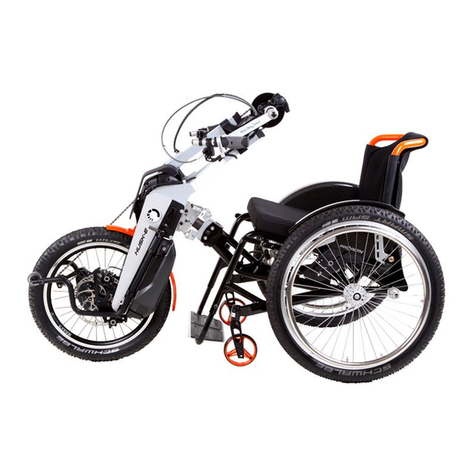
ProActiv
ProActiv HUSK-E Parts list manual
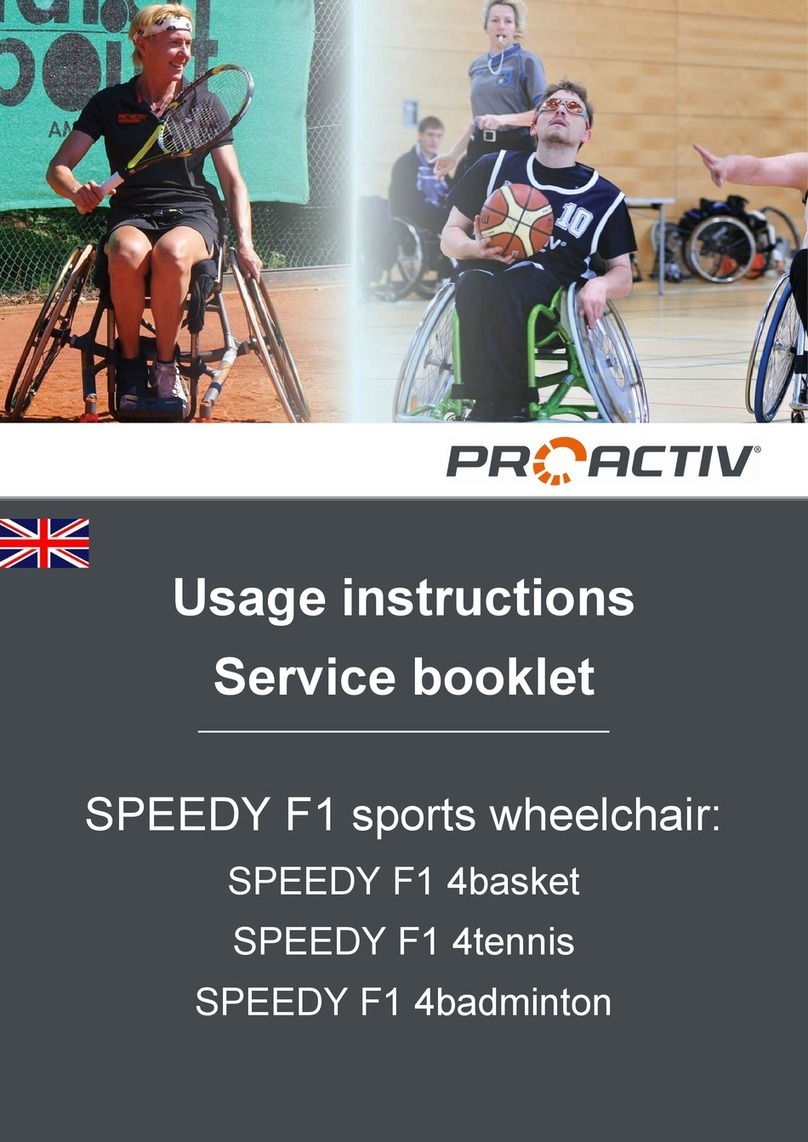
ProActiv
ProActiv SPEEDY F1 User manual
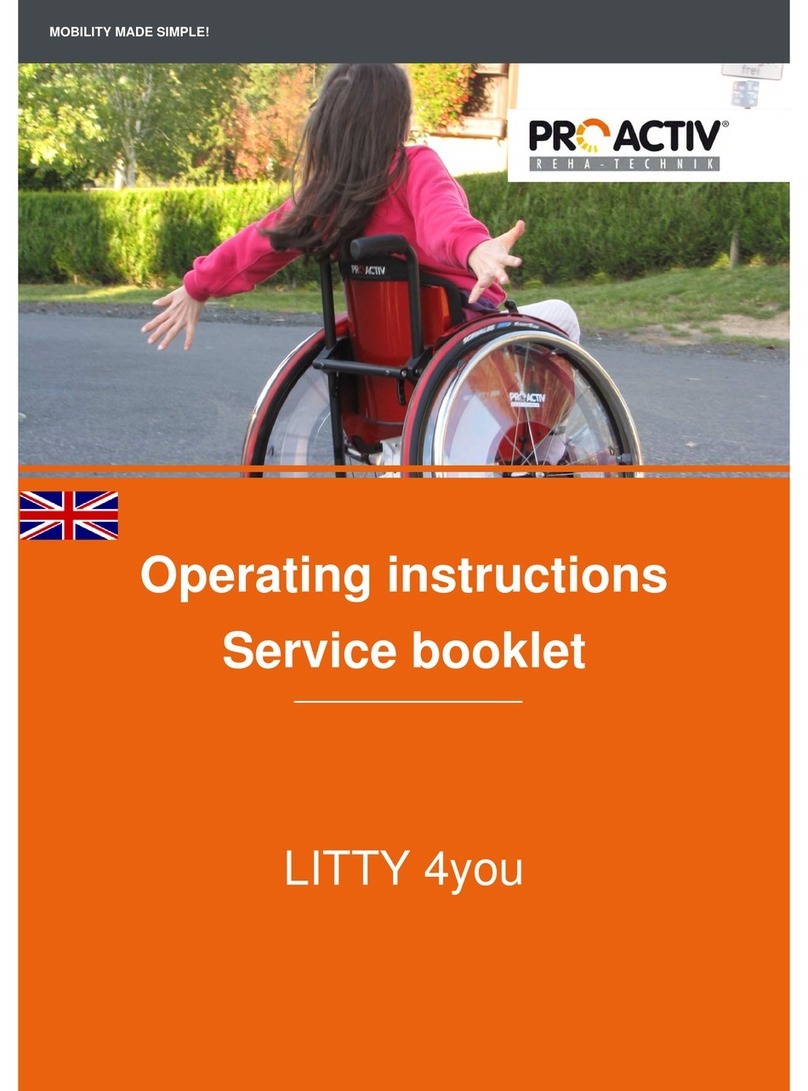
ProActiv
ProActiv LITTY 4you User manual
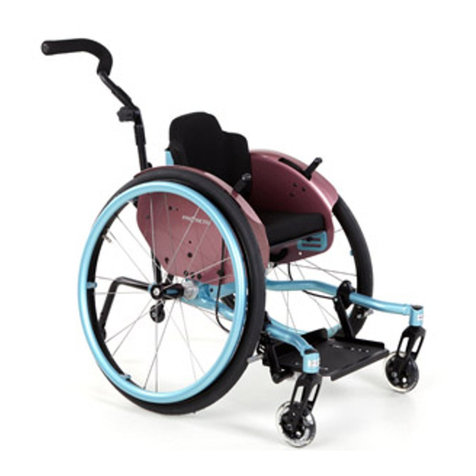
ProActiv
ProActiv LITTY 4all Installation and operation manual
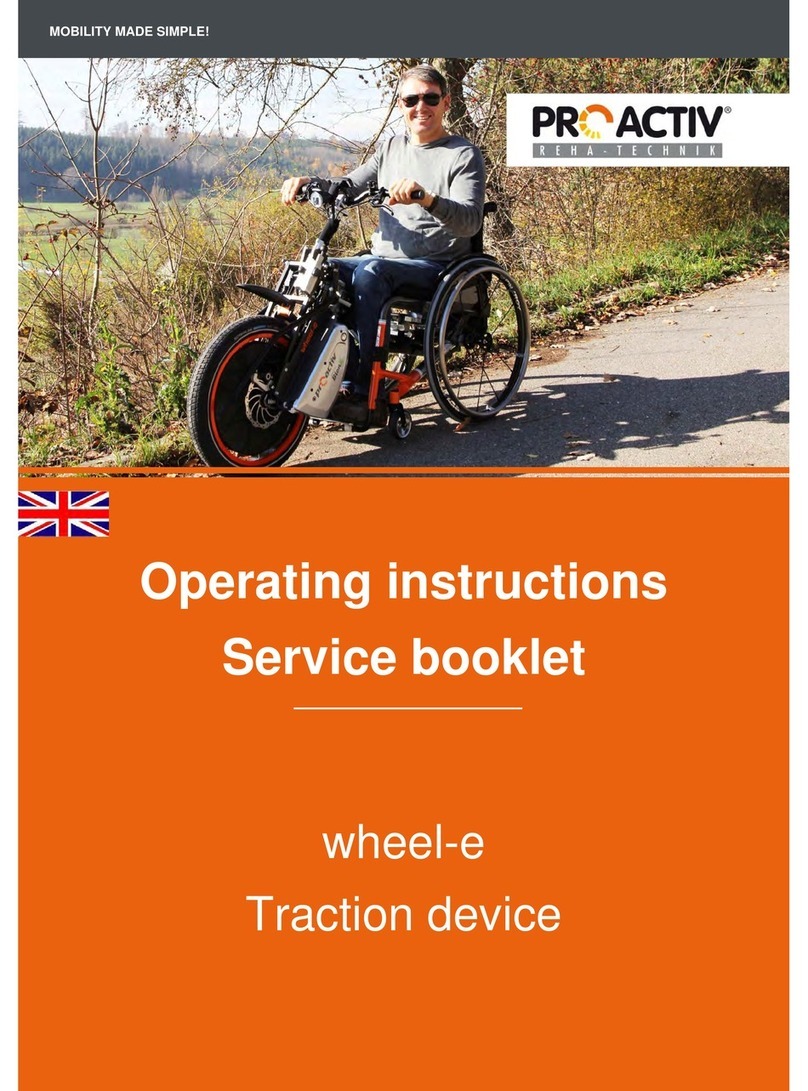
ProActiv
ProActiv wheel-e User manual
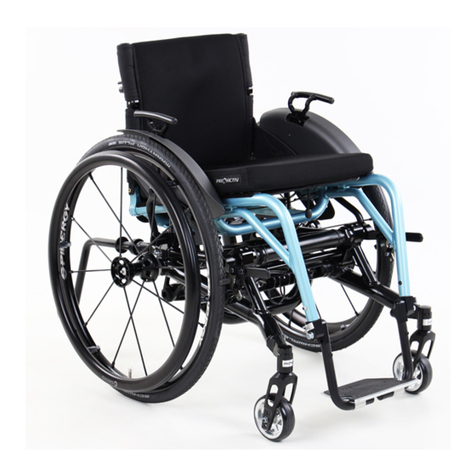
ProActiv
ProActiv LIFT activ Parts list manual
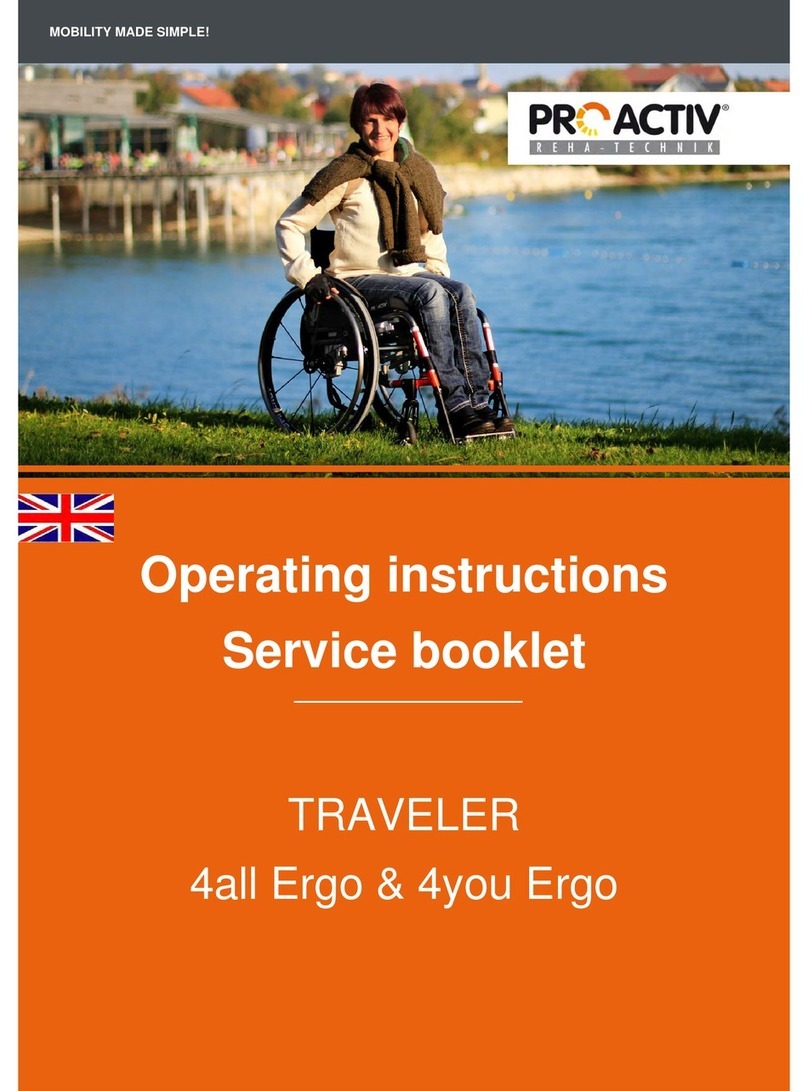
ProActiv
ProActiv TRAVELER 4all Ergo Troubleshooting guide
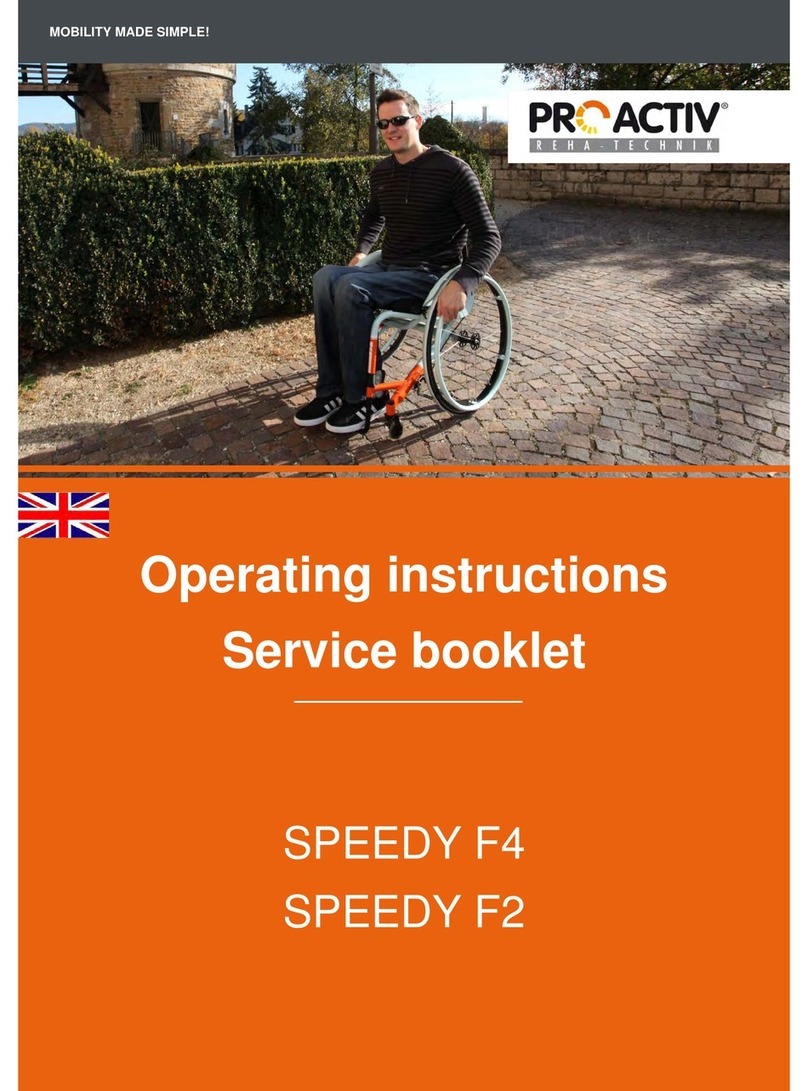
ProActiv
ProActiv SPEEDY F4 Troubleshooting guide
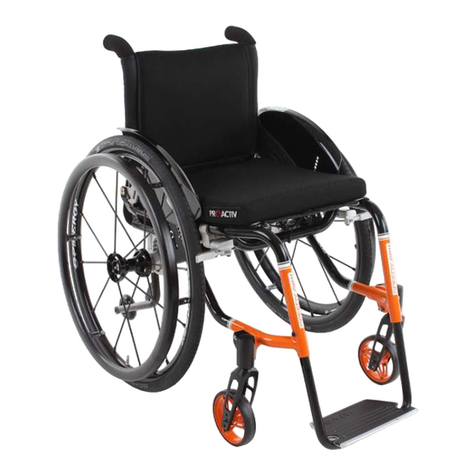
ProActiv
ProActiv SPEEDY 4all Parts list manual
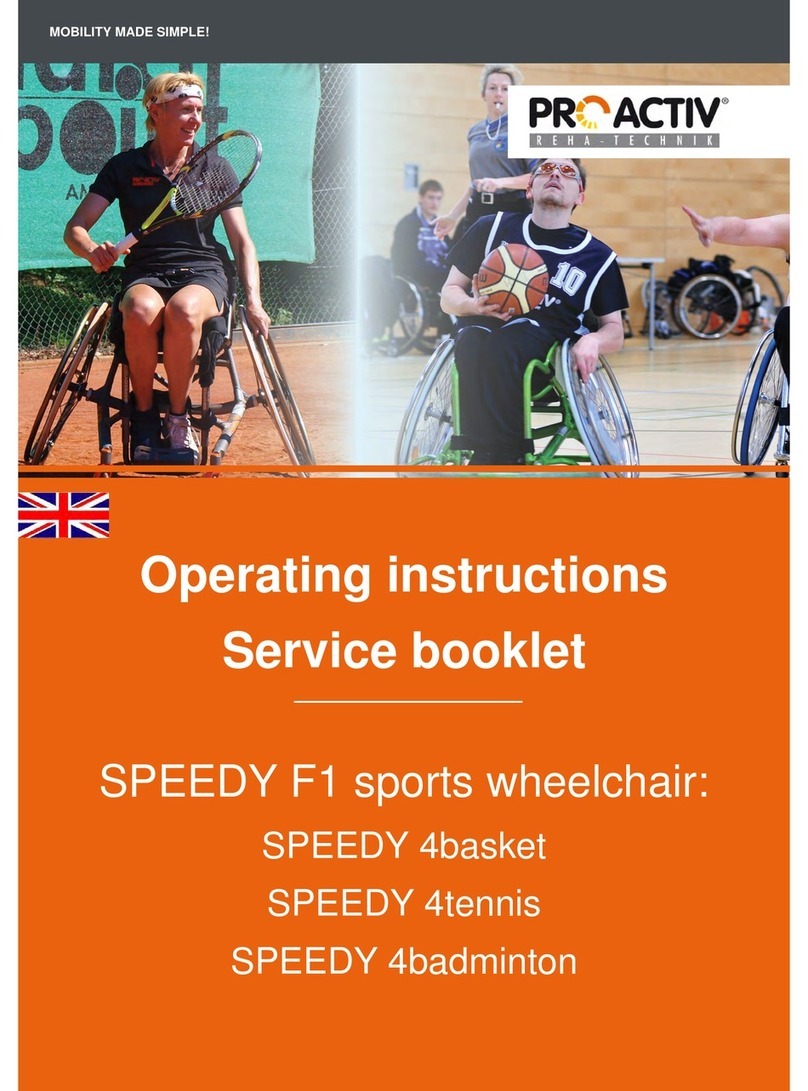
ProActiv
ProActiv SPEEDY F1 Troubleshooting guide

